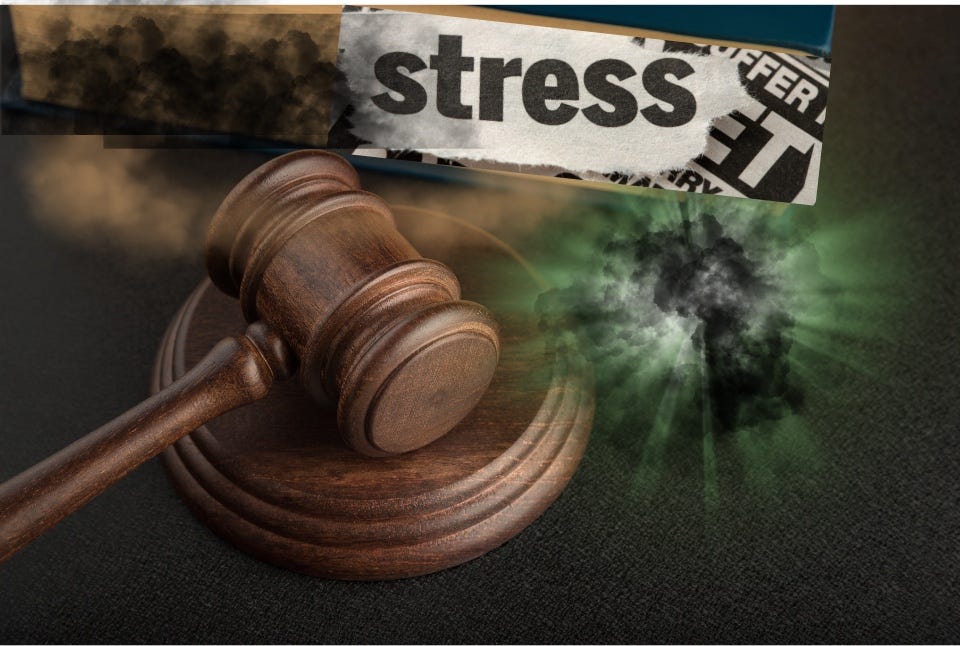The Hidden Strain on India’s District Judges
With nearly 90% of district judges citing heavy workload as a major stressor, addressing their well-being could be key to unlocking India’s justice delivery
View as PDF
Shivaraj Huchhanavar, OP Jindal Global University
Shamim Mohammad, MIT World Peace University
Vikash Vaibhav, OP Jindal Global University
SDG 3: Good Health and Well-being | SDG 16: Peace, Justice and Strong Institutions
Institutions: Ministry of Law and Justice
India’s district judiciary operates under chronic strain. This is not a passing difficulty of early service, but the professional reality across decades. A survey of 50 district judges across 13 High Court jurisdictions found that 90 percent identified excessive workload as a major source of stress, and 73 percent reported constant concern over frivolous complaints.
The implications extend beyond the bench: judicial well-being directly shapes the quality, speed and consistency of justice. Systemically, this strain translates into slower case disposal, lower morale, and erosion of public trust. Yet these same patterns also reveal where targeted reforms can deliver the greatest impact. Understanding why this strain persists, and how it shows up in the everyday work of a judge, is the first step towards that reform.
The Multitude of Judicial Stress
Stress in the district judiciary is not an occasional crisis but a constant climate. Three overlapping categories emerge.
Competence-related stress stems from the intellectual and emotional demands of adjudication: over two-thirds of judges reported the strain of deciding technically complex cases, morally difficult matters, or those with insufficient evidence - often under tight deadlines.
Autonomy-related stress reflects the limited control judges have over the size and composition of their caseloads, the allocation of staff, and the scheduling of hearings. Interference from higher courts, whether through directions or reassignments, further compounds this sense of constrained agency.
Regulatory stress emerged as the most potent driver of psychological strain in the district judiciary. This includes opaque performance evaluations, premature transfers, delays in promotion, and the constant possibility of career-derailing complaints. Statistical analysis confirmed that these service conditions were the strongest predictors of strain.
The human cost of these pressures becomes most apparent when the focus shifts from their causes to their consequences.
From Judicial Strain to Health and Performance
These pressures have tangible impacts. Nearly all judges perceived chronic tiredness and digestive trouble; over 80 percent reported headaches and back pain. Psychological symptoms were equally widespread: memory impairment affected about three-fourth of the surveyed judges, while emotional exhaustion, temper outbursts, and sleeplessness were reported by over 70 percent. Some physical symptoms correlated with personal circumstances such as bereavement or lifestyle diseases, but their prevalence across respondents points to a systemic issue.
The link between health and performance is direct. A judge working through persistent fatigue or pain is less able to sustain the concentration, patience, and precision that complex adjudication demands. The lack of structured institutional support magnifies the impact, but also means the problem is amenable to change through deliberate policy design.
Institutional Gaps, Policy Openings
Some institutional support exists but it remains limited. According to the survey, most judges had attended only a single formal stress management session, typically at the National Judicial Academy, and only a few had access to confidential counselling. Over 80 percent reported experiencing premature transfers, often without explanation or recourse.
Staff shortages affect nearly all courts, while underdeveloped digital infrastructure adds to administrative burdens and limits the use of technology for scheduling and case tracking.
The consequences extend well beyond individual well-being. Judicial strain feeds into slower case resolution and weaker decision quality, which in turn worsen the backlog pressures driving workload; a self-reinforcing cycle that can be broken.
The policy implication is clear: improving judicial working conditions is a direct route to backlog reduction. Three reforms stand out as immediate priorities. Transfers could be structured to support professional growth while preserving court stability. Stronger digital systems, addressing the infrastructure gaps noted earlier could reduce paperwork, free time for deliberation, and enable more precise workload balancing. Additional trained administrative staff would enable judges to focus on adjudication rather than procedural follow-up.
A Path to Resilient Judging
Addressing this embedded reality requires a systemic approach. Mental health care should be a routine feature of judicial support, with confidential counselling and regular clinical assessments available at the district level. Remote options can help overcome barriers of access and stigma.
Career management must be transparent and predictable: transfers, promotions, and performance evaluations should follow clear, communicated criteria and be open to review. Administrative and digital capacity should be strengthened through adequate staffing, dedicated case managers, and upgraded infrastructure for scheduling, evidence management, and performance tracking.
Workload allocation should also reflect not just the number of cases but their complexity and emotional weight, ensuring that judges handling intricate criminal matters or sensitive disputes are not simultaneously burdened with high volumes of routine cases.
These measures would do more than reduce stress; they would enhance decision quality, speed, and consistency. With the right choices, it is possible to create an environment in which judges work at their full human and institutional capacity: faster, fairer, and with the independence of mind that justice demands. The returns will be stronger courts, greater public trust, and a democracy more confident in its rule of law.
View as PDF
Authors:

The discussion in this article is based on authors’ research published in International Journal for Court Administration (Vol 16). Views are personal.


